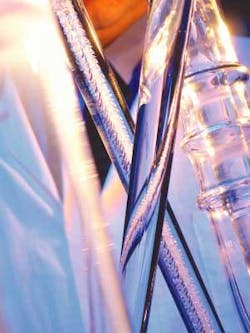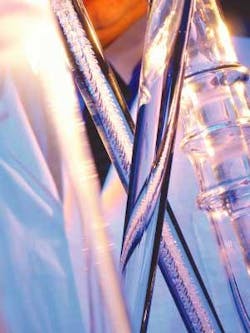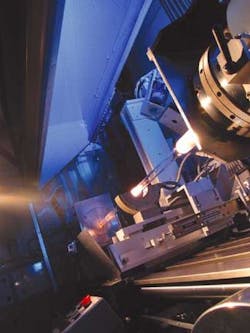By Dr. Chris Emslie
The development of specialty optical fibers for gyroscopes has been an evolutionary process, spanning the last 20 years. Fibercore Ltd., a manufacturer of specialty optical fiber in Southampton, England, commercialized bow-tie polarization-maintaining (PM) fiber in 1983 and since then has used specialty fibers to help gyro manufacturers reduce overall package size and achieve greater reliability, lower cost, and greater accuracy.
The development of gyro fibers at Fibercore has been an evolutionary process spanning 20 years. The company's bow-tie general-purpose fiber required the polarization state of light to be maintained or preserved and used interferometric techniques to improve receiver selectivity and sensitivity in telecommunications applications.
null
The company's first gyro fiber had characteristic bow-tie stress-applying parts, or SAPs, which act like opposing wedges to generate the optimum stress distribution within the fiber to deliver good performance and handling — maximum birefringence, with minimum stress.
Reduced diameter increases reliability
The first modification came in 1984, when York VSOP (Ventures and Specialty optical products), an early incarnation of Fibercore, introduced a polarization-maintaining fiber for sensor use. The modification to the original Hi-Bi fiber reduced the diameter from 125 to 80 microns. At that time, fiber-optic gyros (FOGs) were in the news but still very much in their infancy and customers included the major players in the aerospace and military electronics industries.
This reduction in diameter improved reliability and the ability to coil fiber more tightly as a result of reducing stress levels within the fiber, which enabled a longer length of fiber to be enclosed in the same size package and resulted in greater sensitivity. This development was lost to the rest of the world because of a lack of ancillary components to apply 80-micron fibers widely.
Reducing the fiber diameter reduces the area available for stress members, which raises questions about its ultimate polarization-maintaining ability. This is where bow tie design comes into its own. The bow tie is the most efficient shape for inducing stress within a fiber — resembling, as it does, a pair of opposing wedges. The wedge is one of the simplest machines in existence and has been used for thousands of years to enable the application of stress to be maximized.
Why 80 micron?
Choosing 80 microns resulted in fiber stiff enough to be handled, but allowed greater quantities to be packaged in the same volume casing. At that time, fiber gyro designs were large; coil diameters were around 30 centimeters. Even as late as 1990, the cumbersome nature and poor performance of these early FOGs caused one researcher to project a slide of an AWACS plane, complete with its enormous radar "mushroom," and say, "At last, the fiber gyroscope has found its way onto a real aircraft."
As is common with optoelectronic devices, packaging and interconnection of devices are key issues. At a time that coil diameters were 60 millimeters or larger, bend diameters were 10 millimeters or smaller, and 80 microns accommodated this reduction in coil diameter.
Obtaining components for 80 microns was difficult until about five years ago; until this time, most people made their own components or simply spliced standard 125-millimeter components directly to the 80-micron tails. With practice, such connections are possible with little or no degradation to optical performance, yet they complicate reliability.
This highlights the importance of 80-micron fibers to the gyro. People stuck with 80 micron — even if it meant making their own directional couplers and ancillary products. Furthermore, reducing size and cost results in a move to reduce the diameter of gyro fibers still further. In recent months we have seen renewed interest in 60-micron or even 50-micron fiber.
The continued slump in the telecommunications market makes component manufacturers more willing to devote resources to developing niche components; the move from 80-micron to 60-micron or smaller may occur quickly.
Making the right choice
When considering the diameter of an optical fiber, designers must consider the thickness of the polymer coating that preserves strength and improves handlability. Coating package development and fiber development must be coordinated to create effective, ultra-low-profile fibers.
null
Price is an important part of the fiber-gyro equation. Back in the 1980s the cost of PM fiber for gyros was $20 per meter. Today the average price for volume sales is around $1.50 per meter with the largest users of PM fiber paying close to the "magic" $1 per meter.
Gyros are in everything from vacuums, tractors, trains and aircraft, to military and aerospace applications. The trend is up market, high accuracy, and inexpensive gyros that offer an alternative to ring-laser-based guidance systems seen in airborne and seaborne applications. For this, the gyro must be accurate to better than one degree per hour.
The other "alternative" technology is the MEMS-based (microelectromechanical systems) coriolis sensor that uses a vibrating beam, machined into a silicon crystal. The advantage of MEMS is that thousands of devices can be manufactured using relatively conventional and inexpensive techniques borrowed from the integrated-circuit industry.
So far, the precision of practical MEMS gyros has remained within the range of high tens of degrees per hour — far short of the five degrees or so at which performance becomes interesting for tactical use, yet many potential gyro applications only require the relative (as opposed to absolute) measurements, that current MEMS gyros would allow, for applications like stabilizing motor-vehicle suspension systems.
G-insensitivity
Within a decade, coriolis sensors will achieve acceptable performance for some tactical applications — except those with high levels of acceleration (G-force). It is no coincidence that MEMS has found early success in low-cost, miniature accelerometers.
Although miniaturized and fabricated using IC technology, MEMS gyros share one crucial aspect in common with conventional "spinning mass" gyros: because they are mechanical, rapid acceleration or deceleration can compromise their performance. The fiber-optic gyroscope, on the other hand, is insensitive to mechanical shock; more than a decade ago FOGs performed well on rockets and cannon shells.
There will be other FOG applications, including motor vehicles with GPS systems containing gyros. Anyone who has tried to use GPS after driving around an underground parking garage for long, or has encountered "spaghetti" freeway intersections, knows that GPS fails when it does not receive adequate information.
Heat on gyro fibers
From the mid-1980s to the early 1990s the development of PM fibers rumbled on, yet designers needed FOGs able to operate over temperature ranges of at least –55 to 85 degrees Celsius found in certain military specifications. One of the major restrictions was the temperature dependence of fiber-coating materials. Typical single-coat acrylate resins had glass-transition temperatures of between zero and perhaps 30°C, which caused the material to harden rapidly at subzero temperatures. Any stress-birefringent fiber works by internal stress; this rapid hardening caused external stress from the interaction of different layers of the FOG coil to be transferred directly to the fiber, counteracting its internal stress and degrading performance.
An early solution to this problem was to use a dual-layer coating package comprising a very soft silicone rubber (or hybrid silicone-acrylate) primary (inner) coat and a hard acrylate secondary (outer) coat. The key disadvantages of silicone rubbers, however, derive from three properties — thermal expansion, tensile strength, and adhesion to glass.
Acrylates are typically 10 times stronger, adhere to the glass fiber 10 times harder, and suffer from roughly one-sixth of the thermal expansion of a comparable silicone. Thermal expansion is important because the relatively high temperatures at which coating takes place cause the silicone to be applied in an "expanded" state, promoting delamination from the fiber and the outer coating layer when the coated fiber cools.
For these reasons, Fibercore has never marketed silicone-coated or silicone-acrylate-coated fibers for FOG use; however we did substantial research into the problems silicone caused in gyros and potential resolutions. Our focus has always been on modified acrylates, which offer improved strength and optical properties — and are much easier to handle in a practical FOG manufacturing environment.
This development focus led to the introduction of our HB-G fiber, which has recently undergone a further iteration, using a special primary acrylate that stays soft, even at –55°C — and in doing so, matches the low-temperature performance of the earlier silicones and silicone acrylates, while continuing to provide the strength, handleability, and manufacturability of a more conventional package.
Size, cost, and performance
In the future, the driving forces remain size and cost — preferably without sacrificing performance or long-term strength and reliability. Reducing fiber diameter brings instant gains in reliability through reductions in maximum stress levels for fibers deployed in a coil.
The two mechanical fears for technicians of reduced-diameter fibers are handleability and risk of failure by breaking. This fear is unfounded — primarily because pure tensile failure is not a test of fiber in the manufacture of gyros. Limited data shows that failure tends to occur as a result of "snagging" the fiber such that its minimum bend diameter is exceeded, rather than by accidentally pulling it to destruction.
What determines tensile-breaking load is the cross-sectional area of the fiber; 60-micron fiber will break at a little more than half of the tensile load of a comparable 80-micron fiber. So far, increased manufacturing failure has not been a problem and, in fact, the added flexibility of ultra-low-profile fibers may be providing some added protection from "snagging" failures.
In terms of handleability, the extreme flexibility (and even poor visibility) of a 60-micron fiber can be disconcerting. An 80-micron fiber coated to 155 microns can be felt plainly and indefinitely between the thumb and finger; 60-micron fibers coated to 135 microns disappears between thumb and forefinger once initial sensation has subsided — there is no sensation to tell you that fiber is present.
Ultimately, the success of ultra-low profile depends on effective handling techniques and associated equipment — winders, fusion splicers, fused taper rigs, and ancillary components. Stress birefringent fiber designs may also offset the stress sensitivity brought about by increased flexibility — but to date there are no fundamental showstoppers. We foresee a move to even smaller-diameter fibers as the reduction of the fiber volume enables even smaller or higher-precision FOGs.
Dr. Chris Emslie is managing director of specialty fiber manufacturer Fibercore Limited in Southampton, England. He is available by phone at 011-44-23-8076-9893, by e-mail at [email protected], and online at www.fibercore.com.





